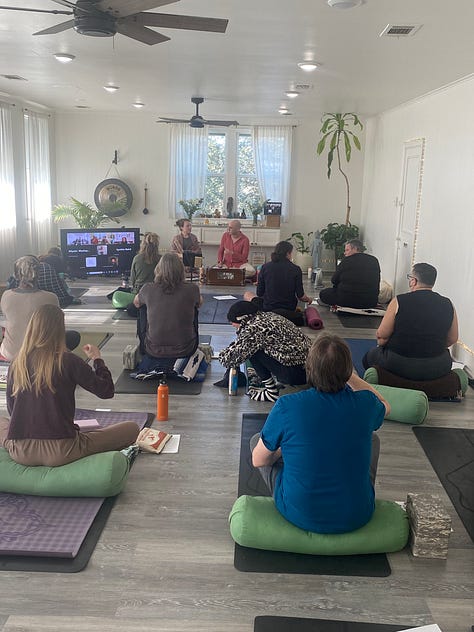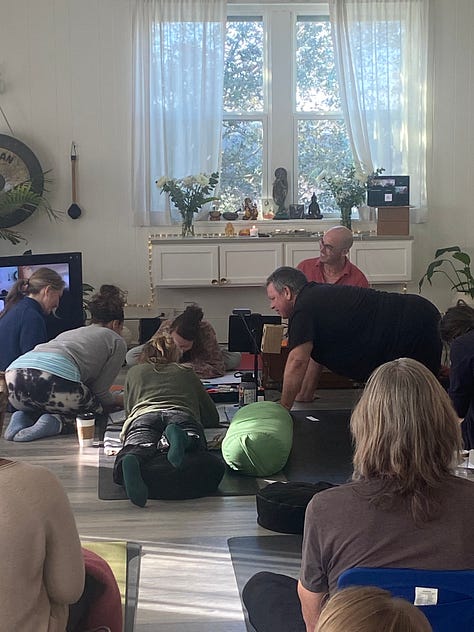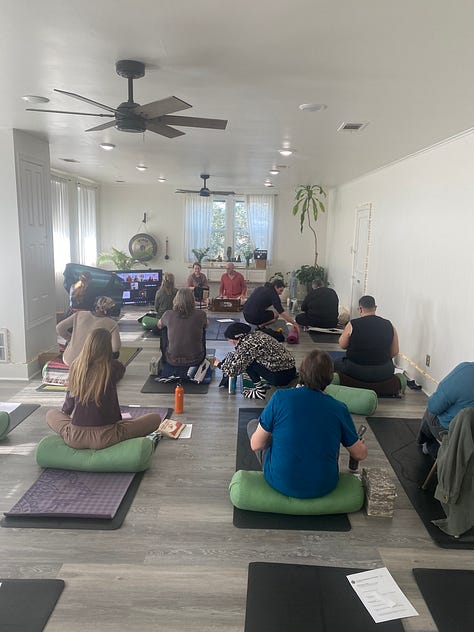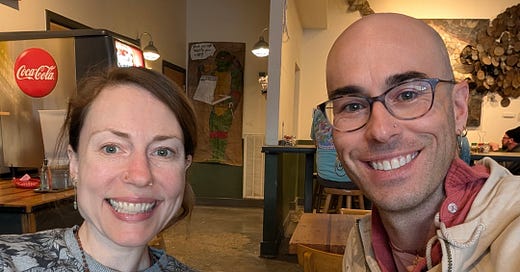Arising from consciousness. Intuition. Inherent desire. ~ Pratibhā.
The practice of dropping into my center, the deepest part of me I have access to, and listening has been something I've worked on for some time. Not listening with words, not for sounds, but for the most subtle of sensations. From that space - that deep, silent, revealing space, I felt my sankalpa. This happened sometime last year as I connected deeper to understanding who I am and what steps it would take to get me there. While I'm far from showing up ~ how I want all the time ~ I'm moving forward and following my heart in the deepest of senses.
Last weekend, Kelly and I held our fourth annual Sankalpa Workshop at Sama Studio with around 25 people in person and on Zoom sharing this practice. It felt like the perfect time for a reset after the way the year started in New Orleans - a beautiful studio, a diverse community, and a space for openness and exploration. I rarely think of myself as a teacher. I think of myself as a guide who gets to share information valuable to me and learn in the company of others. I was fortunate to be surrounded by wisdom throughout the whole day. This is a practice of hrī or humility and something I'm trying to keep central to what I share.
If you didn't get to attend, I hope this allows you to explore your inherent depth.



Introducing Sankalpa and Dharma
Sankalpa can be translated as a deep intention, a sacred vow, a resolve, or a commitment. I talk about it as something that moves you to be who you want to be and guides you to show up how you want to show up in this moment of your life. A sankalpa, in this context, is a guiding star to and in support of your dharma.
Dharma has many meanings, including law, duty, teaching, etc. Dharma, in this context, is life's purpose. Our life is governed by our life's purpose. It's how we show up in the world. It's why I'm writing this; it's why, a few years ago, I primarily worked as a scientist. That was my dharma. But like anything in life, our dharma can change, and our dharma typically does change throughout our lives. I helped in many ways as an environmental scientist, and now I feel like I'm doing what I should as primarily a yoga teacher. Peace Pilgrim, a spiritual teacher, and activist who often spoke in terms of yoga without having experience with yogic teachings, says the same thing in her own way:
“Find your place in the Life Pattern. You have a part in the scheme of things. What that part is you can know only from within yourself. You can seek it in receptive silence. You can begin to live in accordance with this by doing all the good things you are motivated toward and giving these things a priority in your life over all the superficial things that customarily occupy human lives."
But do we have that much control?
While planning this workshop for the fourth year, Kelly asked, "Does this sound like we have all the control? Does it sound like we're bypassing the way things are?"
Do we have this much control? Can we really manifest? Does the Divine have a hand in what happens?
These are tough questions, and in my experience and according to these teachings, we have limited control, except when it comes to our actions, our words, and our thoughts. Thich Nhat Hanh said that:
"our actions are only true belongings; we cannot escape the consequence of our actions"
I think we all can understand that we are responsible for our actions and that with practice, we can act in a way that is in alignment with our dharma. Our actions plant seeds for for our future. This is the whole idea behind karma. The same is true for words. We know when we say something out of character or something that simply doesn't feel right. We feel that in our bodies.
Thoughts are the hardest of the three things we have control over. It's hard to think we have control over our thoughts, right? We have that reflexive instinct, that immediate thought, and while it may feel like we have no control over it, these teachings say otherwise. But, of course, it takes practice and almost constant work of rewiring and planting new seeds. One lady at the workshop shared that she looks at it like this - "I don't have control of my first thought, but I do have control over my second thought." I like that take and that softness.
So we control our actions, thoughts, and, to some degree, our thoughts, but then comes the most essential practice - surrender. As the Bhagavad-gītā says, we must do our actions without being tied to the fruits of our actions. (We'll talk more about surrender in a future essay.)
Contemplation on Dharma
Settle into your seat and take a few breaths. Allow yourself to relax. Drop into your center. Connect to the deepest part of yourself that you have access to. Listen. Listen and attempt to not give words. Instead, feel. Feel the deep center of your being.
Without answering during this meditation, contemplate:
In the deepest part of you, in your intuition. At the soul level. How do you want to show up in the world?
As Peace Pilgrim would say, "Explore your place in life's pattern/the pattern of the world"
Imagine/visualize/feel what that looks like.
Now, take some time to write about anything that came up.
Reflecting on the blocks: What's in the way?
We all have things that get in our way. Be it mental constructs, anxiety, fear, or distractions, we all have to overcome something. This is why it's worth reflecting on what those blocks are. They may be easy, like too much social media or watching the news in the morning, but they can also be quite hard like getting in your own way, not taking enough time for self-reflection or even general fear. The only way to address the blocks is by reflecting on them. To know yourself, you have to study yourself. In the yogic tradition, the word for self-study is svādhyāya. It can also mean introspection. I have a teacher, Dr. Ranganathan, who describes svādhyāya as self-governance, meaning the ability to make decisions and regulate oneself without outside interference.
Reflect on the following prompts:
What tends to drain your energy the most?
Which habits/patterns are holding you back?
What story have you been telling yourself about your limitations? Are they true?
What/if anything, is blocking you from being who you genuinely want to be/doing what you truly want to do in life?
Purify
Finally, decide on one block to work on and write it on a small sheet of paper. At the end of this next practice, you can burn the paper or rip it up into tiny pieces as a symbolic way to let it go.
The following meditation is adapted from a purification practice shared at Sama Studio for the monthly workshop Essence of Practice.
Settle and take a few deep breaths.
First, take refuge in remembering that even the strongest of patterns can be changed with practice. Take refuge in the teachings that everything in this world has the potential to change or be transformed.
Bring awareness to that one thing, the one you want to work on the most.
Commit to some time when you won't do that action and consider what you can do instead. Plant the opposite seed.
Celebrate yourself for all the good actions you've taken in your life to get where you are now.
Now burn your paper or rip it up as you smile!
Determining your Sankalpa
This section is shorter because you've already done much of the work. It might take 30 minutes or days. This is where you have to tap into pratibhā, intuition.
Take a breath. Now, don't answer this right away. Simply read the following questions. Resist answering just yet.
Reflect back on how you want to show up in the world:
What intentions/practices/steps can move you toward your life's greater purpose?
What is your sankalpa/deep intention/resolve?
Now that you've read that go for a walk, do some yoga, meditate on your breath, and take some time without consciously thinking about any of that. Come back later to work on answering the questions.
Now that you're back
Again, reflect back on how you want to show up in the world and write or draw about the following
What intentions/practices/steps can move you toward your life's greater purpose?
What is your sankalpa/deep intention/resolve?
It has helped me to frame my sankalpa as an I-statement. For example: "I am Love", "I am my subtle-body", "I am truth", "I am fearless". Your sankalpa doesn’t even have to be made with words. It can be a picture, and image, or even a feeling.
Working with your sankalpa
The final step is to get creative! How can you display your sankalpa in a creative way? Use colors or stickers. Connect to the inherent artist in you. Make it inspiring to you!
We often recommend writing it on a card or folded paper, which you decorate and then display on your home altar or mirror. Somewhere, you will see it every day.
Now, with softness and gratitude keep coming back to it. It will never be perfect, but you can, through practice, plant this seed. Embody your sankalpa every chance you get.
(I’ll share about my sankalpa in a separate essay!)





I was one of the lucky ones to have attended this workshop and have reflected on my sankalpa that I wrote that day on my card, “I am a success.” Defining that is the process for me, it changes daily. OHM